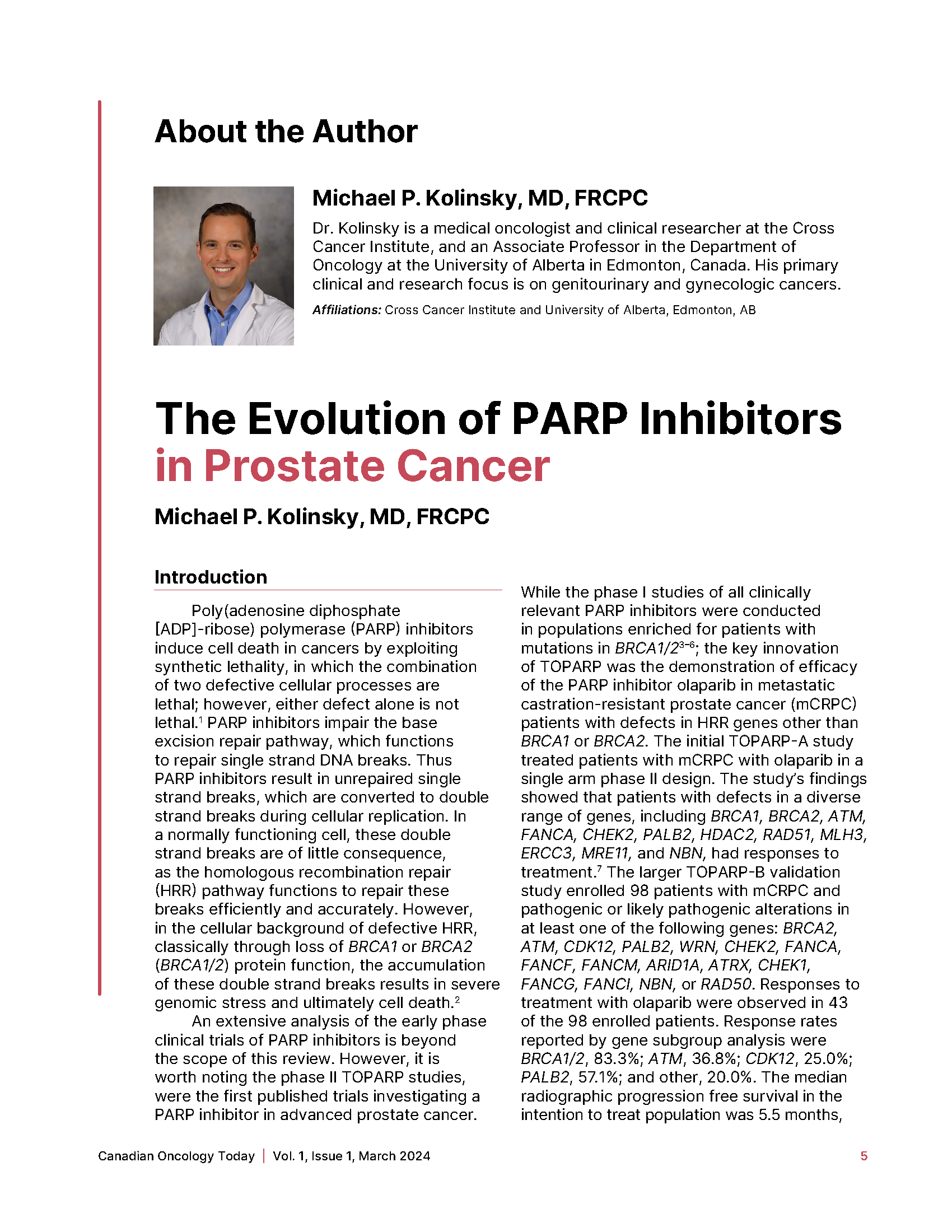The Evolution of PARP Inhibitors in Prostate Cancer
Abstract
Poly(adenosine diphosphate [ADP]‑ribose) polymerase (PARP) inhibitors induce cell death in cancers by exploiting synthetic lethality, in which the combination of two defective cellular processes are lethal; however, either defect alone is not lethal. PARP inhibitors impair the base excision repair pathway, which functions to repair single strand DNA breaks. Thus PARP inhibitors result in unrepaired single strand breaks, which are converted to double strand breaks during cellular replication. In a normally functioning cell, these double strand breaks are of little consequence, as the homologous recombination repair (HRR) pathway functions to repair these breaks efficiently and accurately. However, in the cellular background of defective HRR, classically through loss of BRCA1 or BRCA2 (BRCA1/2) protein function, the accumulation of these double strand breaks results in severe genomic stress and ultimately cell death.
References
Iglehart JD, Silver DP. Synthetic lethality--a new direction in cancer-drug development. N Engl J Med. 2009;361(2):189-191. doi:10.1056/NEJMe0903044
Mateo J, Lord CJ, Serra V, Tutt A, Balmaña J, Castroviejo-Bermejo M, et al. A decade of clinical development of PARP inhibitors in perspective. Ann Oncol. 2019;30(9):1437-1447. doi:10.1093/annonc/mdz192
Fong PC, Boss DS, Yap TA, Tutt A, Wu P, Mergui-Roelvink M, et al. Inhibition of poly(ADP-ribose) polymerase in tumors from BRCA mutation carriers. N Engl J Med. 2009;361(2):123-134. doi:10.1056/NEJMoa0900212
Michie CO, Sandhu SK, Schelman WR, Molife LR, Wilding G, Omlin AG, et al. Final results of the phase I trial of niraparib (MK4827), a poly(ADP)ribose polymerase (PARP) inhibitor incorporating proof of concept biomarker studies and expansion cohorts involving BRCA1/2 mutation carriers, sporadic ovarian, and castration resistant prostate cancer (CRPC). Journal of Clinical Oncology. 2013;31(15_suppl):2513-2513. doi:10.1200/jco.2013.31.15_suppl.2513
Kristeleit R, Shapiro GI, Burris HA, Oza AM, LoRusso P, Patel MR, et al. A phase I-II study of the oral PARP inhibitor rucaparib in patients with germline BRCA1/2-mutated ovarian carcinoma or other solid tumors. Clin Cancer Res. 2017;23(15):4095-4106. doi:10.1158/1078-0432.Ccr-16-2796
de Bono J, Ramanathan RK, Mina L, Chugh R, Glaspy J, Rafii S, et al. Phase I, dose-escalation, two-part trial of the PARP inhibitor talazoparib in patients with advanced germline BRCA1/2 mutations and selected sporadic cancers. Cancer Discov. 2017;7(6):620-629. doi:10.1158/2159-8290.Cd-16-1250
Mateo J, Carreira S, Sandhu S, Miranda S, Mossop H, Perez-Lopez R, et al. DNA-repair defects and olaparib in metastatic prostate cancer. N Engl J Med. 2015;373(18):1697-1708. doi:10.1056/NEJMoa1506859
de Bono JS, Matsubara N, Penel N, Mehra N, Kolinsky MP, Bompas E, et al. Exploratory gene-by-gene analysis of olaparib in patients (pts) with metastatic castration-resistant prostate cancer (mCRPC): PROfound. Journal of Clinical Oncology. 2021;39(6_suppl):126-126. doi:10.1200/JCO.2021.39.6_suppl.126
Hussain M, Mateo J, Fizazi K, Saad F, Shore N, Sandhu S, et al. Survival with olaparib in metastatic castration-resistant prostate cancer. N Engl J Med. 2020;383(24):2345-2357. doi:10.1056/NEJMoa2022485
Fizazi K, Piulats JM, Reaume MN, Ostler P, McDermott R, Gingerich JR, et al. Rucaparib or physician’s choice in metastatic prostate cancer. N Engl J Med. 2023;388(8):719-732. doi:10.1056/NEJMoa2214676
Kwon DH, Booth CM, Prasad V. Untangling the PROfound trial for advanced prostate cancer: is there really a role for olaparib? Eur Urol. 2021;79(6):710-712. doi:10.1016/j.eururo.2021.02.041
Li L, Karanika S, Yang G, Wang J, Park S, Broom BM, et al. Androgen receptor inhibitor-induced “BRCAness” and PARP inhibition are synthetically lethal for castration-resistant prostate cancer. Sci Signal. 2017;10(480). doi:10.1126/scisignal.aam7479
Asim M, Tarish F, Zecchini HI, Sanjiv K, Gelali E, Massie CE, et al. Synthetic lethality between androgen receptor signalling and the PARP pathway in prostate cancer. Nat Commun. 2017;8(1):374. doi:10.1038/s41467-017-00393-y
Clarke N, Wiechno P, Alekseev B, Sala N, Jones R, Kocak I, et al. Olaparib combined with abiraterone in patients with metastatic castration-resistant prostate cancer: a randomised, double-blind, placebo-controlled, phase 2 trial. Lancet Oncol. 2018;19(7):975-986. doi:10.1016/s1470-2045(18)30365-6
Clarke NW, Armstrong AJ, Thiery-Vuillemin A, Mototsugu O, Shore N, Loredo E, et al. Abiraterone and olaparib for metastatic castration-resistant prostate cancer. NEJM Evid. 2022;1(9). doi:DOI: 10.1056/EVIDoa2200043
Saad F, Clarke NW, Oya M, Shore N, Procopio G, Guedes JD, et al. Olaparib plus abiraterone versus placebo plus abiraterone in metastatic castration-resistant prostate cancer (PROpel): final prespecified overall survival results of a randomised, double-blind, phase 3 trial. Lancet Oncol. 2023;24(10):1094-1108. doi:10.1016/s1470-2045(23)00382-0
Mirza RM, Gonzalez AM, Graybill W, O’Malley DM, Gaba L, Yap OWS, et al. Evaluation of an individualized starting-dose of niraparib in the PRIMA/ENGOT-OV26/GOG-3012 study. Journal of Clinical Oncology. 2020;38(15_suppl):6050-6050. doi:10.1200/JCO.2020.38.15_suppl.6050
Li N, Zhu J, Yin R, Wang J, Pan L, Kong B, et al. Treatment with niraparib maintenance therapy in patients with newly diagnosed advanced ovarian cancer: a phase 3 randomized clinical trial. JAMA Oncol. 2023;9(9):1230-1237. doi:10.1001/jamaoncol.2023.2283
Madan RA, Karzai F, VanderWeele DJ, Cheng HH, de Bono JS. Poly(ADP-ribose) polymerase inhibitor combinations in first-line metastatic castration-resistant prostate cancer: increasing toxicity with unclear benefits. J Clin Oncol. 2023;41(36):5501-5504. doi:10.1200/jco.23.01502
Pan Canadian Oncology Drug Review. pCODR Expert Review Committee (pERC) FINAL RECOMMENDATION. 2021. [updated April 21 2021; cited 2024 January 6]. Disponible au : https://www.cadth.ca/sites/default/files/pcodr/Reviews2021/10223OlaparibmCRPC_fnRec_REDACT_EC21Apr2021_final.pdf.
Parker C, Nilsson S, Heinrich D, Helle SI, O’Sullivan JM, Fosså SD, et al. Alpha emitter radium-223 and survival in metastatic prostate cancer. N Engl J Med. 2013;369(3):213-223. doi:10.1056/NEJMoa1213755
de Bono JS, Oudard S, Ozguroglu M, Hansen S, Machiels JP, Kocak I, et al. Prednisone plus cabazitaxel or mitoxantrone for metastatic castration-resistant prostate cancer progressing after docetaxel treatment: a randomised open-label trial. Lancet. 2010;376(9747):1147-1154. doi:10.1016/s0140-6736(10)61389-x
Sartor O, de Bono J, Chi KN, Fizazi K, Herrmann K, Rahbar K, et al. Lutetium-177-PSMA-617 for metastatic castration-resistant prostate cancer. N Engl J Med. 2021;385(12):1091-1103. doi:10.1056/NEJMoa2107322

Published
How to Cite
Issue
Section
License
Copyright (c) 2024 Canadian Oncology Today

This work is licensed under a Creative Commons Attribution-NonCommercial-NoDerivatives 4.0 International License.
